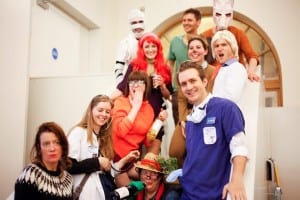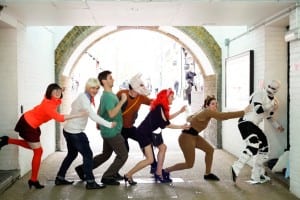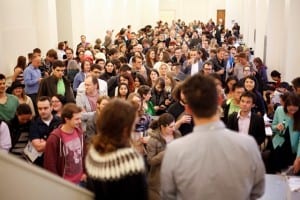A UCL Museums Murder Mystery
By Dean W Veall, on 25 August 2015
Dean Veall here. UCL Museums, comprising of UCL Art Museum, Petrie Museum of Egyptian Archaeology and the Teaching and Research Collections and us, teamed up for an evening of dark noir, intrigue and subterfuge in celebration of Museums at Night 2015. A crime had been committed on campus and with prizes to be won we invited visitors to solve this museum murder mystery.
A UCL Museums Murder Mystery
Friday 15 May, 6.30pm to 9pm
Treasure Hunt
What happened
Organised anarchy is what happened! Here at the Grant Museum we have traditionally teamed up with the other UCL Museums to combine our efforts for the annual festival of Museums that is Museums at Night and 2015 was no exception. Last year we decided to re-package the evening that was usually a treasure hunt into a murder mystery evening and it proved crazy popular, so why change the format, so this year we ran another murder mystery to equal success. Conceptually still a treasure hunt, the night took inspiration from Cluedo (other crime based board games are available) where there had been a murder on campus and the audience had to solve in which of the museums the murder took place, with what object from the collection and by which of the historic figures associated with the museums.
Part of the fun of the night was the dressing up, we advertised that there were prizes to be won for best dressed and visitors got right into the spirit. Amongst the team we also plundered the rich resource of fictional sleuths and had not one but two Sarah Lunds along with a Miss Marple. After briefing the assembled mass of visitors about the evening and the rules of the game we set them loose on the Bloomsbury campus to solve the case by collecting digits that made up a telephone number, there were digits associated with the historic figures and spaces and by solving clues to discover which of the specimens found more digits. However, the digits collected could not form a number until a final dramatic reveal of the missing code to put them all together at the end of the night. A hush descended across the crowd of detectives as we waited for the first team to text and be crowned the winner.

Our very own Sarah Lund with the winners who solved the mystery along with best costumes, including the Scooby gang and Rosemary and Thyme
Facts and Figures
309 people attended the evening. Here are some fancy graphs to illustrate the age breakdown of who came. And one for percentage of new visitors attending a UCL Museums event. The event cost us around £250 in total which include prizes (vouchers), printing and paying for a cash bar provided by UCL caterers Sedexco.
Feedback
The overwhelming experience of visitors was a positive one.
‘Really enjoyed it however and running aorund!’
‘Great fun’
‘Really well done! A lot of fun!’
One theme that strongly emerged in the comments left on the events feedback form was praise for the events format as a way to engage visitors with the collections.
‘Really, it was excellent! The clues were very good! Very fun, I had no idea UCL had so many museum rooms’
‘Great to go into these hidden gems… brilliant idea to get us really looking at objects. Will definitely be back to look in more detail at a later date!’
As always there was constructive feedback from the visitors that will be of great help next year should we run it again. Primarily the comments consisted of clearer instructions and improving the sound quality.
Lessons from Programming
Difficulty rating – 2/5 stars.
Many hands did indeed make light work, with the combined forces of the public programming staff we were able to deal with the logistics of 300+ people in our spaces.
Logistics
This was the biggest challenge we faced, last year we had upwards of 400 people turn up to the event only to turn away half the number due to size of lecture theatre. Anticipating another bumper year we booked a bigger space and upped the print run for instruction manuals. With spaces all across campus and 300 people who had not been to them before we needed all hands on deck to hel/p navigate around some of the hidden museums and collections, so one tip is get as many people as you can and then some when hosting such a large scale event.
New Visitors
This event format was brilliant at helping get new visitors to our museums as shown in the feedback data, although not necessarily a key aim for the public programme at the Grant Museum or the wider UCL Museums it certainly doesn’t hurt, especially given the demographic and how they shared their experiences via social media.
Marketing
Get on board a campaign. This is old news, especially given the success of Museums at Night, but we benefited from their marketing machine and also the recognition of the brand with media outlets such as TimeOut. So, given the sheer volume of events that likely happened in museums across London on that night we fared very well in the competition with our event at capacity.
Would we do this event again? Yes, definitely!
Dean Veall is Learning and Access Officer at the Grant Museum of Zoology
 Close
Close





